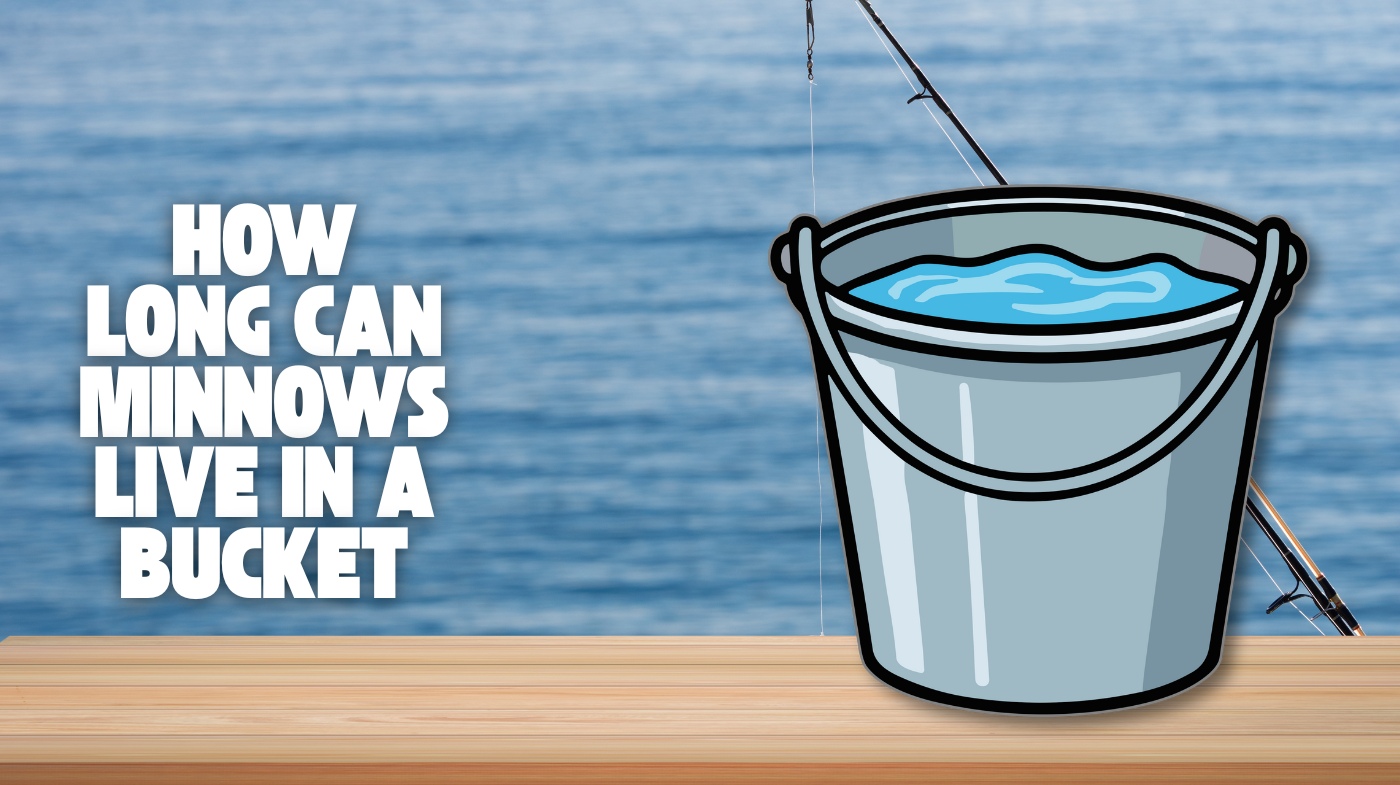How Long Can Minnows Live in a Bucket? Stay Informed
You can keep minnows alive in a bucket for several days if you manage oxygen, temperature, and water quality carefully. Use a battery-operated aerator to maintain oxygen levels above 3 mg/L.
Keep water temperature below 60°F and change water gradually with dechlorinated fresh water. Remove dead fish promptly and avoid overcrowding to reduce stress and disease risks.
For detailed strategies on extending minnow survival and maintaining healthy conditions, explore additional expert recommendations.
Key Takeaways
- Minnows typically survive 1 to 3 days in a bucket without aeration and water changes.
- Aerators and regular partial water changes can extend survival up to a week or more.
- Keeping water temperature below 60°F and oxygen above 3 mg/L is essential for longevity.
- Overcrowding and buildup of waste rapidly decrease oxygen and water quality, shortening survival.
- Removing dead fish promptly and minimizing handling reduces stress and disease risk, prolonging life.
Factors Influencing Minnow Survival in Buckets
Although keeping minnows in a bucket seems simple, several critical factors influence their survival.
Oxygen levels are paramount; overcrowding and warm, stagnant water reduce dissolved oxygen, increasing mortality. You need to avoid crowding and consider bucket size to dilute waste and sustain oxygen. Using an aquarium air pump or shaking the water can help increase dissolved oxygen levels effectively. Additionally, using materials with waterproofing properties can help maintain stable water conditions.
Ammonia buildup from fish waste rapidly poisons minnows in confined spaces, so partial daily water changes and prompt removal of dead fish are essential.
Temperature also plays a vital role. Cold water holds more oxygen and slows metabolism, while warm water raises stress and mortality risks.
Additionally, stress factors like frequent handling, lack of shelter, predator presence, and noise can weaken minnows’ immune responses, further decreasing survival chances.
Essential Equipment for Prolonging Minnow Life
Maintaining ideal conditions for minnows in a bucket depends not only on understanding environmental factors but also on using the right equipment.
Success in keeping minnows healthy hinges on both environment and the proper gear.
A battery-operated aerator is essential to maintain dissolved oxygen, running continuously to prevent suffocation, especially in warm or crowded conditions. An inexpensive aerator (~$12) suitable for up to 20 gallons ensures sufficient oxygen levels, especially for 5-gallon setups.
Confirm the aerator matches your bucket size and minnow count to optimize oxygen levels.
Use an insulated plastic or metal bucket to stabilize water temperature and prevent rapid fluctuations.
Treat tap water with a dechlorinator or use untreated freshwater sources to avoid toxicity. Dechlorinator neutralizes harmful chemicals in tap water, making it safe for bait and fish.
Fine-mesh nets protect minnows during transfer, minimizing stress and contamination risk.
Backup batteries and secondary containers support uninterrupted care and facilitate water changes.
Regularly monitor water clarity and temperature to identify issues early, ensuring your minnows survive longer with minimal stress and mortality.
Best Practices for Maintaining Minnow Health
Because minnows are sensitive to environmental changes, you need to carefully manage water temperature, oxygen levels, and cleanliness to keep them healthy. Maintaining clean water is essential to prevent harmful bacteria and odors.
Maintain water below 60°F, ensure dissolved oxygen exceeds 3 mg/L, and conduct gradual water changes to prevent shock. Larger fathead minnows are particularly temperature sensitive, so maintaining proper temperature is crucial to their health. Minimize handling and keep the bucket clean to reduce stress and disease risk.
Use an aerator for consistent oxygen supply and place the bucket in a shaded area to stabilize temperature.
| Factor | Suitable Range/Action | Purpose |
|---|---|---|
| Temperature | Below 60°F | Reduces stress and prolongs life |
| Dissolved Oxygen | > 3 mg/L | Supports respiration |
| Water Changes | Gradual, temperature-matched | Prevents shock |
| Handling | Minimize | Reduces stress and injury |
Common Challenges When Keeping Minnows in Buckets
When keeping minnows in buckets, you must address several challenges that directly affect their survival. Oxygen depletion occurs rapidly in stagnant water, especially with overcrowding, causing suffocation. Using a simple aerator to introduce oxygen can help prevent suffocation by continuously oxygenating the water. Selecting equipment with a durable frame material can improve longevity and performance in outdoor conditions.
Dead minnows further reduce oxygen and degrade water quality, so you need to remove them promptly. Temperature fluctuations also stress minnows. Sudden changes or overheating above 70°F increase mortality.
Removing dead minnows quickly and avoiding temperature spikes above 70°F are vital to their survival.
Maintaining preferred temperatures between 50–70°F is critical. Water quality deteriorates from waste buildup and toxic chemicals like chlorine, requiring clean, dechlorinated water and cautious partial changes. Changing water every 24 hours ensures fresh conditions and reduces harmful buildup.
Overcrowding raises stress and disease susceptibility due to limited space and oxygen. Provide ample volume and monitor behavior.
Inadequate feeding, either starvation or overfeeding, weakens minnows and worsens water quality. Balancing these factors ensures better minnow survival during storage.
Tips for Long-Term Storage of Minnows
Although storing minnows long-term presents challenges, you can considerably improve their survival by selecting proper containers and managing water quality carefully.
Use oxygen-permeable materials with built-in aerators. Ensure regular water changes using chlorine-free fresh water and maintain stable temperatures.
Minimize overcrowding and provide hiding places to reduce stress.
| Container Features | Water Quality Tips | Maintenance Practices |
|---|---|---|
| Oxygen-permeable mesh | Change 2/3 water daily | Clean containers often |
| Built-in aerators | Use chlorine-free water | Monitor pH and temp |
| Durable and easy-clean | Avoid overcrowding | Provide hiding spots |
Following these guidelines helps maintain oxygen levels, water purity, and environmental stability. These factors are vital for minnows’ health during extended storage. Additionally, storing minnows in a cold, oxygen-rich water environment further enhances their longevity and well-being.
Frequently Asked Questions
Can Minnows Survive in Saltwater Buckets?
You can’t keep typical freshwater minnows alive in saltwater buckets because they experience osmotic stress, leading to dehydration and death.
Only mud minnows tolerate short-term exposure to brackish water, and even they won’t survive full-strength saltwater for long.
To maintain minnows successfully, use freshwater or brackish conditions with proper aeration, temperature control, and filtration.
Saltwater buckets without these adaptations cause rapid mortality for standard bait minnows.
Do Minnows Need to Be Fed Daily in a Bucket?
Think of your minnows as tiny engines. They need fuel to keep running smoothly. Yes, you should feed minnows daily when they’re in a bucket to maintain their health and energy.
Balanced feeding prevents starvation and supports metabolic functions. However, avoid overfeeding, as excess food degrades water quality and harms them.
Provide suitable fish food or small crumbs, and monitor water conditions closely to sustain a healthy environment that mimics their natural habitat.
How Often Should I Replace the Water in the Bucket?
You should replace the water in the bucket every 24 hours to maintain ideal minnow health.
For longer storage, change about 75% of the water every couple of days. Always match the new water’s temperature closely to prevent thermal shock and never replace all the water at once.
Promptly remove any dead minnows during changes to avoid water quality deterioration. Use dechlorinated or distilled water to guarantee safety.
Is It Safe to Keep Minnows Overnight Without Aeration?
Imagine a tiny crowd trapped in a sealed room with dwindling air. That’s your minnows overnight without aeration.
It’s only safe if you keep them cool, in a spacious bucket, with fresh, chlorine-free water, and a shaded spot.
Without oxygen replenishment, they risk suffocation within 12–24 hours.
To improve survival, avoid overcrowding, change water regularly, and consider aeration or slow water drips.
Otherwise, overnight storage without aeration is risky.
Can I Use Tap Water Directly for Minnows in a Bucket?
You shouldn’t use tap water directly for minnows in a bucket because chlorine and chloramine are toxic and can kill them quickly.
Always treat tap water with a water conditioner to neutralize harmful chemicals before adding it.
Let the water reach room temperature, aerate it, and test for pH and toxins.
Proper preparation guarantees minnows survive longer and stay healthy in your bucket environment.
Keep Your Minnows Thriving — Even in a Bucket
Keeping minnows alive in a bucket is like balancing on a tightrope. You need precision and care.
By controlling water temperature, oxygen levels, and cleanliness, you markedly extend their survival time.
Using proper equipment and following best practices helps maintain their health and reduces stress. Remember, common challenges like waste buildup can quickly become a ticking time bomb.
With careful attention and the right techniques, you can keep your minnows thriving even in such a confined space.







